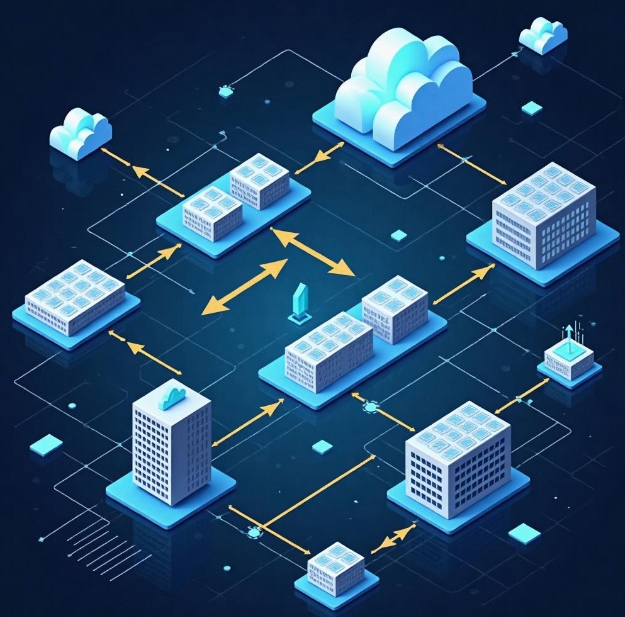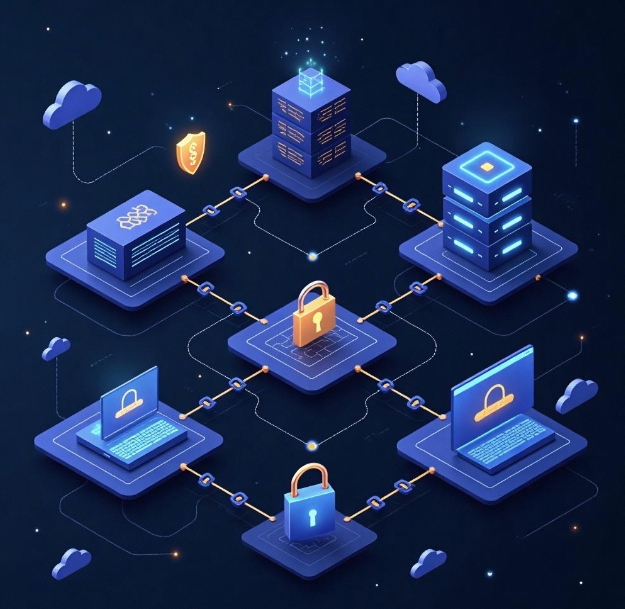On-chain and off-chain interaction in Web3 development: How to achieve data synchronization?
- latest articles
- 1.DApp Development & Customization: Merging Diverse Market Needs with User Experience 2.Analysis of the Core Technical System in DApp Project Development 3.How to achieve cross-chain interoperability in Web3 projects? 4.How does the tokenization of points reconstruct the e-commerce ecosystem? 5.How to Set and Track Data Metrics for a Points Mall? 6.What is DApp Development? Core Concepts and Technical Analysis 7.Inventory of commonly used Web3 development tools and usage tips 8.Development of a Distribution System Integrated with Social E-commerce 9.Six Key Steps for Businesses to Build a Points Mall System 10.What is DApp Development? A Comprehensive Guide from Concept to Implementation
- Popular Articles
- 1.Future Trends and Technology Predictions for APP Development in 2025 2.Analysis of the DeFi Ecosystem: How Developers Can Participate in Decentralized Finance Innovation 3.From Zero to One: How PI Mall Revolutionizes the Traditional E-commerce Model 4.DAPP Development | Best Practices for Professional Customization and Rapid Launch 5.Recommended by the Web3 developer community: the most noteworthy forums and resources 6.From Cloud Computing to Computing Power Leasing: Building a Flexible and Scalable Computing Resource Platform 7.How to Develop a Successful Douyin Mini Program: Technical Architecture and Best Practices 8.Shared Bike System APP: The Convenient Choice in the Era of Smart Travel 9.How to Create a Successful Dating App: From Needs Analysis to User Experience Design 10.From Design to Development: The Complete Process of Bringing an APP Idea to Life
With the continuous development of blockchain technology, Web3 has become a crucial component of the next-generation internet. The core characteristics of Web3 lie in its decentralization, openness, and transparency, providing users with greater control, especially in data management and digital identity. However, the application of Web3 is not limited to smart contracts and token transfers within the blockchain; it also involves the interaction and synchronization of on-chain and off-chain data. How to achieve effective data synchronization between on-chain and off-chain has become a key challenge in Web3 development. This article will explore in detail the challenges of on-chain and off-chain interaction in Web3 development and discuss current technical means for achieving data synchronization.
I. Background and Importance of On-Chain and Off-Chain Interaction
In the traditional internet, data storage and processing typically occur on centralized servers, whereas in Web3, data storage and computation are primarily distributed across blockchain networks and decentralized applications (DApps). This distributed architecture brings the advantages of decentralization but also presents challenges in data synchronization and interaction.
On-chain data: Refers to data stored on the blockchain, typically including the state of smart contracts, transaction records, and block information. The advantages of on-chain data lie in its immutability and transparency.
Off-chain data: Refers to data stored outside the blockchain, typically including user data, application computation results, and external API calls. Off-chain data processing is faster, but compared to on-chain data, it may have trust and security issues.
Applications in Web3 often require interaction between these two types of data. Smart contracts and off-chain data need to be synchronized to ensure the integrity and consistency of the application. Therefore, on-chain and off-chain interaction and data synchronization are a crucial aspect of Web3 development.
II. Challenges of On-Chain and Off-Chain Interaction
The difficulties in on-chain and off-chain data interaction are mainly reflected in the following aspects:
Performance Issues: Blockchain has limited processing capacity, especially in data storage and processing. On-chain data access is typically slow, and operational costs are high. Therefore, how to improve data interaction efficiency while maintaining the decentralization and security of the blockchain is an urgent problem to solve.
Data Consistency: On-chain data is typically immutable, while off-chain data may change with external system variations. Ensuring that on-chain and off-chain data remain consistent during state updates and avoiding data conflicts or inconsistencies is a challenge developers face.
Security: The management of off-chain data often relies on centralized data storage, which may have security vulnerabilities. Therefore, ensuring that off-chain data is not tampered with during transmission while protecting its privacy is an important consideration when developing Web3 applications.
Limitations in Data Storage and Computing Capacity: Due to the limited storage space of blockchains, directly storing large amounts of data on-chain is neither practical nor efficient. Therefore, how to effectively combine off-chain and on-chain storage has become a key challenge in Web3 development.
III. Technical Means for Solving On-Chain and Off-Chain Data Synchronization
To address the above challenges, Web3 developers have proposed various technical solutions and tools to achieve on-chain and off-chain data synchronization and interaction. The following are some of the main technical means:
1. Oracles
Oracles are one of the most common technical means for on-chain and off-chain interaction. The role of an oracle is to transmit external world data to the blockchain, enabling smart contracts to access off-chain data and make corresponding decisions. By providing access to external data sources, oracles solve the information isolation between the blockchain and the off-chain world.
For example, Chainlink is a very famous decentralized oracle platform that provides off-chain data through multiple data sources and ensures data accuracy and security. Smart contracts obtain off-chain data by calling oracles and then perform corresponding operations.
2. Layer 2 Solutions
To improve the scalability and performance of blockchains, Layer 2 solutions have emerged. Layer 2 is a protocol layer that operates outside the blockchain, processing a large number of transactions off-chain to reduce the burden on the main chain and improve processing efficiency. For example, technologies such as Plasma, Optimistic Rollups, and zk-Rollups are common Layer 2 solutions.
In Web3 applications, off-chain data processing can be enhanced through Layer 2 solutions, while final data settlement and confirmation are completed on the main chain. This way, on-chain and off-chain data synchronization can ensure efficiency while maintaining security and decentralization.
3. Decentralized Storage Systems
Decentralized storage systems (such as IPFS, Arweave, etc.) provide off-chain data storage solutions for Web3. These systems store large amounts of data in a decentralized manner, avoiding the single point of failure issues that traditional centralized servers may bring. Only critical data is stored on-chain, preventing excessive on-chain data expansion.
Through decentralized storage, Web3 applications can store most data off-chain while ensuring data security and long-term accessibility. The on-chain storage retains core data closely related to application logic, maintaining the advantages of decentralization.
4. Cross-Chain Technology
Cross-chain technology enables different blockchains to exchange data and value. In Web3 applications, cross-chain technology can help synchronize on-chain and off-chain data effectively, especially in multi-chain applications where cross-chain capabilities become particularly important. Through cross-chain protocols, data can flow between different blockchains, achieving synchronization across various chains.
For example, Cosmos and Polkadot are two well-known cross-chain platforms that provide infrastructure for interoperability between blockchains. Through these cross-chain technologies, developers can build complex Web3 applications and achieve on-chain and off-chain data synchronization.
5. Smart Contracts and Event Triggering Mechanisms
Smart contracts can set events that trigger corresponding operations when certain conditions are met. This event-driven mechanism can assist in synchronizing on-chain and off-chain data. For example, when a transaction or state change occurs on-chain, a smart contract can trigger an event to notify the off-chain system to perform corresponding updates.
The advantage of this approach is that changes in on-chain state can immediately notify the off-chain system, ensuring data synchronization and consistency. By combining event monitoring mechanisms in off-chain applications, more efficient on-chain and off-chain data interaction can be achieved.
IV. Practical Applications of On-Chain and Off-Chain Interaction
On-chain and off-chain data synchronization has a wide range of practical application scenarios. The following are a few typical examples:
Decentralized Finance (DeFi): In DeFi protocols, on-chain data (such as asset status and smart contract execution) needs to be synchronized with off-chain data (such as external price information and liquidity pool status). Oracles play a crucial role in this scenario, providing timely market data to smart contracts, enabling DeFi applications to make decisions based on external data.
NFTs (Non-Fungible Tokens): The purchase and trading of NFTs typically rely on on-chain smart contracts, while NFT metadata (such as images, videos, and audio) is usually stored off-chain. Ensuring consistency between on-chain and off-chain data is an issue that cannot be overlooked in NFT applications. Decentralized storage systems like IPFS provide effective solutions to this problem.
Supply Chain Management: In supply chain management, synchronization of on-chain and off-chain data is crucial. Blockchain can be used to record transactions and transportation information, while off-chain IoT devices can collect logistics information in real-time. Through oracles and event-driven mechanisms, the blockchain can ensure synchronization between off-chain and on-chain data, thereby improving supply chain transparency and efficiency.
V. Summary
The emergence of Web3 marks the arrival of the decentralized era of the internet, and on-chain and off-chain data synchronization is a technical challenge that cannot be ignored in Web3 applications. By using oracles, Layer 2 solutions, decentralized storage, cross-chain technology, and smart contract event triggering mechanisms, developers can achieve effective synchronization of on-chain and off-chain data, ensuring application security, efficiency, and decentralization.
With the continuous development of Web3 technology, the implementation of on-chain and off-chain interaction will become more efficient and convenient. In the future, as decentralized applications become more widespread, the seamless integration of on-chain and off-chain will provide users with a more secure, transparent, and efficient digital experience, promoting the widespread application and development of Web3.
-

How to achieve cross-chain interoperability in Web3 projects?
With the continuous development of WEB3 technology, Web3 has gradually become an···
-

Inventory of commonly used Web3 development tools and usage tips
With the continuous development of blockchain technology, Web3 has become a hot ···
-

Web3 development trend prediction: analysis of future technology directions and application scenarios
With the gradual development of blockchain technology, the concept of Web3 has m···

 Blockchain
Blockchain












